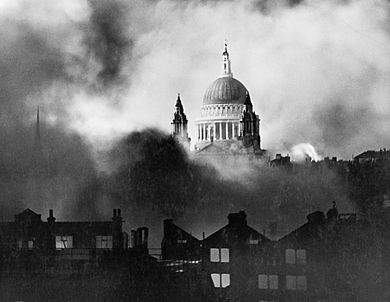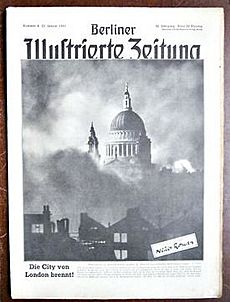St Paul's Survives facts for kids

The famous photo St Paul's Survives was taken in London during a huge air raid on the night of December 29–30, 1940. This was the 114th night of a period called the Blitz during World War II. The picture shows St Paul's Cathedral standing tall, lit up by fires and surrounded by smoke from burning buildings. A photographer named Herbert Mason took it early on December 30 from the roof of Northcliffe House, which was the office of the Daily Mail newspaper.
This photograph quickly became a powerful symbol of British strength and bravery. It is now seen as one of the most important images from the Blitz. It made the Cathedral a sign of hope and survival for many people. The air raid when the photo was taken was so big it was called the "Second Great Fire of London". More than 160 people died, over 500 were hurt, and hundreds of buildings were destroyed.
What Was the Blitz?
The Blitz was a long period of bombing attacks on Great Britain and Northern Ireland by Nazi Germany. It happened between September 7, 1940, and May 10, 1941, during World War II. The German air force, called the Luftwaffe, bombed London, the capital city of the United Kingdom, for 57 nights in a row. Over one million homes in London were either destroyed or damaged. More than 40,000 regular people were killed, and half of them were in London.
When the "St Paul's Survives" picture was taken, almost every building around St Paul's Cathedral had burned down. The Cathedral stood in a ruined area. It survived mostly because of special firewatchers. Prime Minister Winston Churchill had asked them to protect the Cathedral. Twenty-nine fire bombs landed on or near the Cathedral. One even burned through the lead roof of the dome and almost fell into the wooden beams supporting it. But the bomb rolled off the roof onto a lower part of the building, where volunteers quickly put it out.
How the Picture Was Taken
The photo was taken on the night of December 29/30, 1940. This was the 114th night of the Blitz. Herbert Mason, the main photographer for the Daily Mail newspaper, was on the roof of his office building, Northcliffe House. He was there to watch for fires. German bombs destroyed many buildings that night, and thick black smoke filled the air. Mason wanted a clear shot of St Paul's. He waited for hours for the smoke to clear enough.
The photograph was taken early on a Monday morning. It was approved by the government's censors to be printed in the Daily Mail on Tuesday, December 31, 1940. It was the main picture on the front page, with the words "War's Greatest Picture" as its caption. The image was cropped to remove many of the damaged buildings around the Cathedral. The Daily Mail also did something unusual: they published the photographer's own story of how he took the picture.
I focused at intervals as the great dome loomed up through the smoke. Glares of many fires and sweeping clouds of smoke kept hiding the shape. Then a wind sprang up. Suddenly, the shining cross, dome and towers stood out like a symbol in the inferno. The scene was unbelievable. In that moment or two I released my shutter.
—Herbert Mason
However, it's important to know that Mason's story might not be exactly how it happened. A detailed study by Brian Stater showed that the final picture was heavily changed in the studio. He found that "more of the picture has been changed than not" after it was taken.


